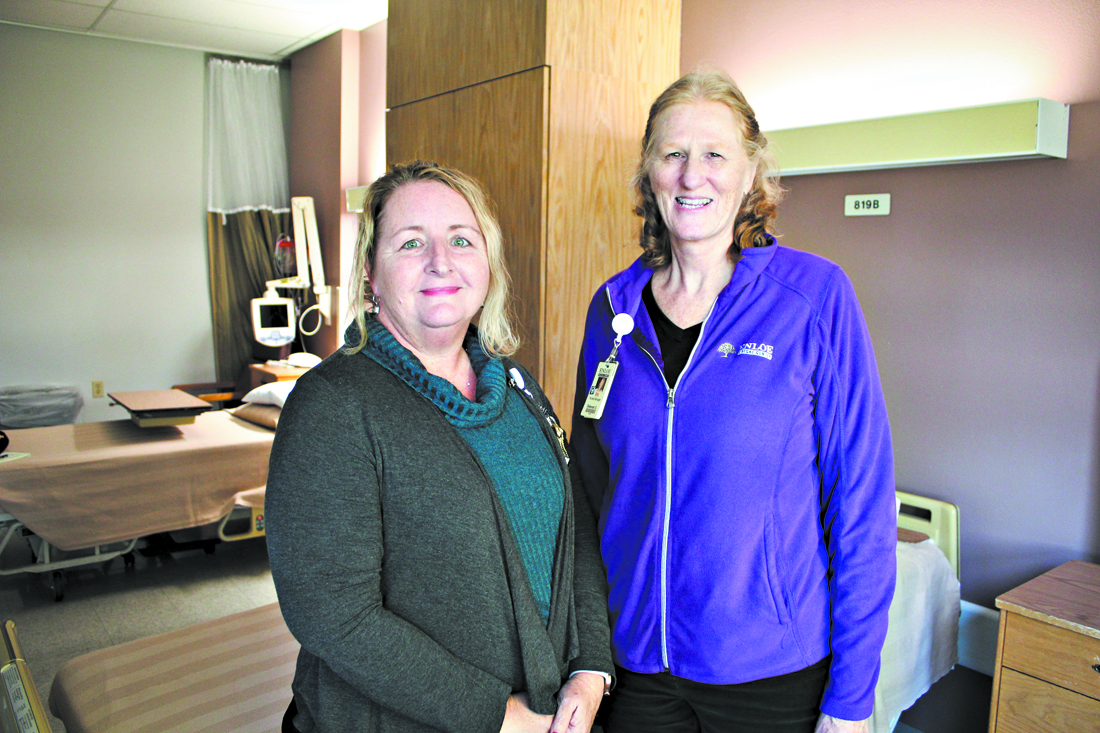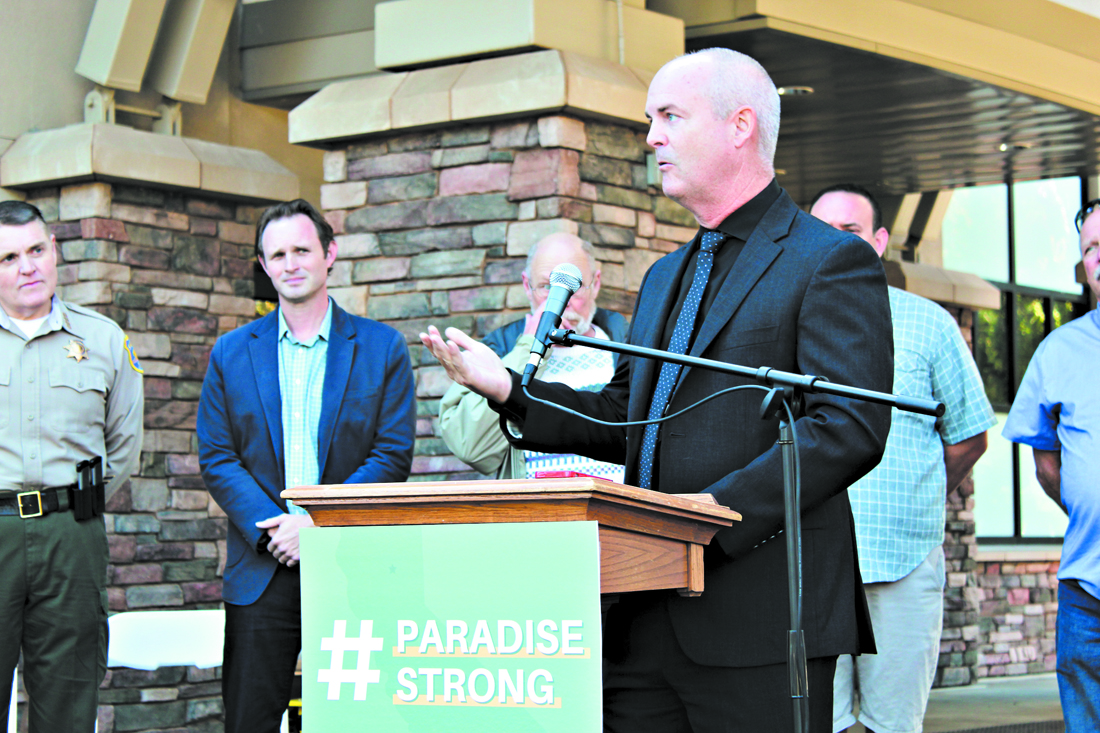
Photo by Ashiah Scharaga
Michelle Evans, Enloe’s director of case management (left), and Transitional Skilled Unit Nurse Manager Debbie Strukan stand in a room at the Enloe Rehabilitation Center reserved for patients needing skilled-nursing care.
Enloe Medical Center hadn’t planned on operating a nursing home, but the Camp Fire changed everything last November, wiping out nearly 300 skilled-nursing beds on the Ridge overnight.
The hospital had to do something to meet the unprecedented demand, CEO Mike Wiltermood told the CN&R. Now, Enloe is running a new Transitional Skilled Unit (TSU) made up of 20 beds within the hospital’s rehabilitation center on East Avenue.
During a recent tour, Michelle Evans, Enloe’s director of case management, said the unit has provided much-needed relief to the community, because “it’s one more resource” Enloe can offer to keep patients local and near their families. But space is limited, forcing health care providers to have tough conversations with patients, Evans said. Some are referred outside of Butte County for longer-term care because there are no local nursing home beds available.
One year after the blaze devastated Butte County, shuttering Ridge nursing homes and Adventist Health Feather River Hospital, the health care landscape continues to present challenges for the region’s largest hospital. There is some good news: Last month, Adventist Health announced plans to reopen its emergency room. Hospital officials, however, gave no indication of when its doors might open—leaving Enloe and Oroville Hospital the only options for those services and many others.
Across the board, the Chico hospital—the county’s only level II trauma center—has struggled to meet the increased demand for services, Wiltermood said. In-patient volume went from about 190 patients to as many as 280 per day after the fire. Emergency room visits jumped by about 100 more patients daily. Meanwhile, labor and delivery has seen a roughly 50 percent increase in births.
“We’re feeling the stress of this additional patient volume and we don’t really have the capital to expand right now,” Wiltermood said.
Nursing home services have been one of the most significant demands. Enloe has found itself in an odd predicament, he continued: It has received a temporary waiver from the state to provide the care at the TSU until Jan. 25 without meeting certain building requirements. But because the hospital is not considered a licensed skilled-nursing facility, it is unable to bill Medi-Cal and Medicare.
And that’s not all: Enloe expanded its patient capacity immediately after the fire, securing licensing that allowed the facility to accommodate 14 additional patients awaiting placement in a nursing home. Doing so meant reopening the North Wing of the hospital, which had been used for offices and storage for the previous six years. Now that the TSU is open at Enloe’s rehabilitation center across town, the wing holds 10 beds for medical-surgical patient overflow.
However, even with the new accommodations, given the ongoing shortage of nursing home spaces in the community, patients are staying in the hospital longer, Wiltermood explained. Once they reach their maximum reimbursement from Medi-Cal and Medicare, the hospital cannot bill for additional services. He estimates Enloe is spending about $20,000 to $40,000 more per day on about 20 to 40 such patients.
“People think that it was maybe an economic boon to Enloe to get all this extra business, but it’s really not true,” Wiltermood said.
Enloe is looking to bring in more funding to defray the cost of these additional patients. One idea was pursuing what’s called a sole community hospital designation with the Centers for Medicare & Medicaid Services (CMS). It is designed to support small rural hospitals when they are the “sole source of inpatient hospital services reasonably available in a geographic area to Medicare beneficiaries” due to being in an isolated location, weather or travel conditions or lack of other hospitals.
If such a designation were granted, Wiltermood estimates the hospital could bring in an additional $20 million to $40 million per year. But the application was denied. Enloe is planning to plead its case to an appeals board, Wiltermood told the CN&R.
Before the fire, Enloe didn’t qualify because of its proximity to Feather River Hospital. After the Ridge facility closed, Wiltermood said Enloe didn’t qualify because the Oroville population was included as part of its primary market.

Photo by Ashiah Scharaga
Supervisor Doug Teeter offers his support of Adventist Health and its pursuit of a standalone emergency room. On Nov. 8, 2018, Teeter sought refuge at the campus with other fire survivors.
“We don’t think it’s reasonable or reflective of our importance to our community to include the Oroville population in the analysis,” Wiltermood said, “because what that does is supplant places like Durham, Willows and other places that are highly dependent on our hospital.”
Wiltermood noted that Enloe is paying a lot more for employee overtime and contracted work to shore up services due to the region’s exodus of health care providers. The additional funding would not only help the hospital pay for the care, but also replace critical imaging equipment, such as MRIs and CT scanners, and recruit physicians, which is “extremely expensive” and tough because of the lack of housing.
“We are essentially making the argument our whole health care system has been disrupted and we need some assistance,” Wiltermood said. “Enloe Medical Center has been filling in the gaps created by the loss of so many services after the fire. We believe this is a reasonable request that would bring health care dollars into the county to help us meet the needs of the expanded Medicare population.”
Local elected officials, including Chico Mayor Randall Stone and Congressman Doug LaMalfa, have shown their support by sending letters to CMS.
“The bottom line is that, with the loss of Feather River Hospital in Paradise, it’s needed,” LaMalfa told the CN&R.
Meanwhile, though Oroville’s population also ballooned like Chico’s post-Camp Fire, Oroville Hospital CEO Robert Wentz said the health care provider was able to comfortably accommodate additional patients—about a 10 percent increase. This is because the hospital secured licensing for 20 additional beds post-disaster, and had already been planning for a 2022 expansion to increase capacity to 211 patients, from its current post-fire accommodation of 153 (see “Growth served,” Healthlines, March 7, 2019).
It was a “surreal” moment for Doug Teeter standing outside the entrance to Feather River’s emergency room last month. He was there with several other speakers—including Sen. Jim Nielsen and Assemblyman James Gallagher—to commemorate the passage of Senate Bill 156, which allows Adventist Health to operate the facility as a standalone emergency room through 2027.
The last time the county supervisor was on the hospital’s campus was Nov. 8, 2018. That day, survivors were stuck there for hours as the fire raged around them.
“I watched those [medical offices] burn down as we were here trying to make the elderly and infirm comfortable,” he told the CN&R.
Adventist Health CEO Rick Rawson couldn’t provide a timeline for the reopening, because the hospital has a lot figure out. The utility plant, which was damaged in the fire, has to be repaired, and the organization will need federal and state support to proceed, he said. It also has to draft a plan for staffing and transferring patients to other area hospitals should they need trauma care, for example.
But the hospital intends to run a 24/7 emergency room, which Rawson said will be critical not only for Paradise residents but also for those living in Magalia and outlying Ridge communities.
Michelle John, the superintendent of Paradise Unified School District, already knows the ER will make a difference for students: “We’ve actually had a couple of broken bones on the football field, and kids have had to be transported, in pain, off of the Ridge,” she told those at the hospital’s campus that day.
In Teeter’s view, the ER will help repopulate the Ridge, because of the economic, health and safety benefits it will offer. “To see Adventist Health willing to invest back into a community that has a lot of challenges,” he told the CN&R, “it’s going to make a huge difference for a lot of people.”
Over the past year, Adventist Health has been working to restore its services in the region. It reopened its Paradise clinic, offering primary and specialty services, and opened a walk-in clinic in Paradise. In Chico, it launched a Cancer Care Center and expanded primary and specialty services. In addition to the emergency room, Adventist Health also plans to help re-establish a Butte County EMS base station in Paradise utilizing a $49,000 grant from the Butte Strong Fund.
“That’s not lost on us, that what we do and how we invest can influence [the regrowth of the Ridge],” Rawson said. “So instead of just reacting, what we want to do is be a partner and really help Paradise and the Ridge as it grows and redevelops, and really serve all of Butte County.”
